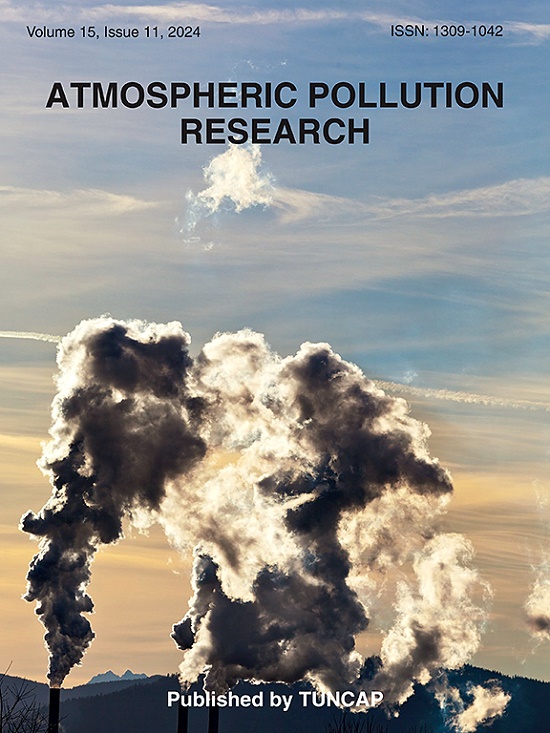Assessing capability of Copernicus Atmosphere Monitoring Service to forecast PM2.5 and PM10 hourly concentrations in a European air quality hotspot
IF 3.5
3区 环境科学与生态学
Q2 ENVIRONMENTAL SCIENCES
引用次数: 0
Abstract
The accuracy of Copernicus Atmosphere Monitoring Service (CAMS) European forecasts of PM2.5 and PM10 hourly concentrations was assessed against hourly observations collected from low-cost stations during the 2022–2023 heating season in the Padana Plain (Italy). The intercomparison of all 11 air quality models integrated into the CAMS framework returned root mean square error (RMSE) values ranging 20.3–37.5 (PM2.5) and 22.2–37.8 μg/m3 (PM10 concentrations), while hourly variation of observations was poorly captured (r = 0.16–0.41 and 0.25–0.47, respectively). Agreeing with prior research, CAMS models exhibited a marked daily variability in forecasting particulate matter (PM) observations, with the largest discrepancies occurring during the early morning and evening hours. PM2.5 observations were best predicted by the CHIMERE model, while PM10 observations by the MINNI model. CAMS Ensemble returned the best r values among all models, while, since all (or the majority of) models over-predicted the observations, it failed to best fit their magnitude, returning mean bias of +8.1 for PM2.5 and +4.0 μg/m3 for PM10 concentrations.
This study demonstrated that further efforts are still needed to improve the performance of CAMS models in estimating PM concentrations. However, rather than acting on model final output, e.g. by implementing bias-correction techniques, a more robust strategy could be to act upstream, i.e. by adjusting the settings of the individual CAMS models. The latter could include a more region-specific characterisation of the emission input data to avoid unrealistic overweighting of anthropogenic emissions, increasing the number of surface stations used for PM concentration assimilation, or adjusting PM chemical composition.
哥白尼大气监测服务预测欧洲空气质量热点地区PM2.5和PM10小时浓度的能力评估
利用意大利帕达纳平原2022-2023年采暖季低成本气象站每小时观测数据,对哥白尼大气监测服务(CAMS)欧洲地区PM2.5和PM10每小时浓度预报的准确性进行了评估。整合到CAMS框架中的所有11个空气质量模型的相互比较得到的均方根误差(RMSE)值为20.3-37.5 (PM2.5)和22.2-37.8 μg/m3 (PM10浓度),而观测值的逐小时变化很难捕捉到(r分别为0.16-0.41和0.25-0.47)。与先前的研究一致,CAMS模型在预测颗粒物(PM)观测值方面显示出显著的日变化,最大的差异发生在清晨和傍晚。CHIMERE模式对PM2.5的预测效果最好,而MINNI模式对PM10的预测效果最好。CAMS Ensemble在所有模型中返回的r值最好,然而,由于所有(或大多数)模型都对观测值进行了过度预测,因此无法最好地拟合它们的量级,PM2.5和PM10浓度的平均偏差分别为+8.1和+4.0 μg/m3。该研究表明,CAMS模型在估算PM浓度方面的性能仍需进一步改进。然而,与其对模型的最终输出采取行动,例如通过实施偏差校正技术,不如采取更稳健的策略,即通过调整单个CAMS模型的设置,在上游采取行动。后者可以包括对排放输入数据进行更具体的区域描述,以避免不现实地高估人为排放,增加用于PM浓度同化的地面站的数量,或调整PM的化学成分。
本文章由计算机程序翻译,如有差异,请以英文原文为准。
求助全文
约1分钟内获得全文
求助全文
来源期刊

Atmospheric Pollution Research
ENVIRONMENTAL SCIENCES-
CiteScore
8.30
自引率
6.70%
发文量
256
审稿时长
36 days
期刊介绍:
Atmospheric Pollution Research (APR) is an international journal designed for the publication of articles on air pollution. Papers should present novel experimental results, theory and modeling of air pollution on local, regional, or global scales. Areas covered are research on inorganic, organic, and persistent organic air pollutants, air quality monitoring, air quality management, atmospheric dispersion and transport, air-surface (soil, water, and vegetation) exchange of pollutants, dry and wet deposition, indoor air quality, exposure assessment, health effects, satellite measurements, natural emissions, atmospheric chemistry, greenhouse gases, and effects on climate change.
 求助内容:
求助内容: 应助结果提醒方式:
应助结果提醒方式:


